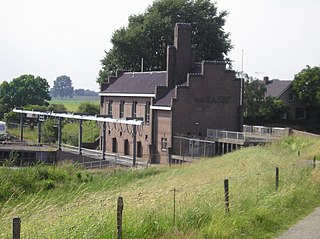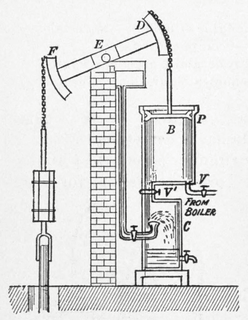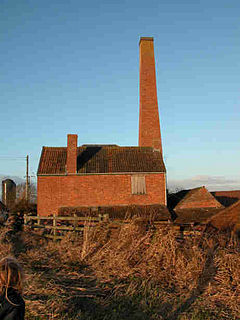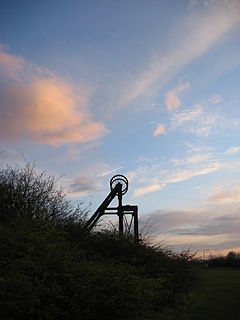
The Bluebell Railway is an 11 mi (17.7 km) heritage line almost entirely in West Sussex in England, except for Sheffield Park which is in East Sussex. It is managed by the Bluebell Railway Preservation Society. It uses steam trains which operate between Sheffield Park and East Grinstead, with intermediate stations at Horsted Keynes and Kingscote.

The Smethwick Engine is a Watt steam engine made by Boulton and Watt, which was installed near Birmingham, England, and was brought into service in May 1779. Now at Thinktank, Birmingham Science Museum, it is the oldest working steam engine and the oldest working engine in the world.

Pumping stations, also called a pumphouse in situations such as drilled wells and drinking water, are facilities including pumps and equipment for pumping fluids from one place to another. They are used for a variety of infrastructure systems, such as the supply of water to canals, the drainage of low-lying land, and the removal of sewage to processing sites. A pumping station is, by definition, an integral part of a pumped-storage hydroelectricity installation.

The Hoorn–Medemblik heritage railway operated by the Museumstoomtram Hoorn Medemblik is a heritage railway in the Netherlands. It runs from Hoorn to Medemblik, a distance of about 20 km (12.4 mi).

A beam engine is a type of steam engine where a pivoted overhead beam is used to apply the force from a vertical piston to a vertical connecting rod. This configuration, with the engine directly driving a pump, was first used by Thomas Newcomen around 1705 to remove water from mines in Cornwall. The efficiency of the engines was improved by engineers including James Watt, who added a separate condenser; Jonathan Hornblower and Arthur Woolf, who compounded the cylinders; and William McNaught, who devised a method of compounding an existing engine. Beam engines were first used to pump water out of mines or into canals but could be used to pump water to supplement the flow for a waterwheel powering a mill.

London Museum of Water & Steam is an independent museum founded in 1975 as the Kew Bridge Steam Museum. It was rebranded in early 2014 following a major investment project.

The Westonzoyland Pumping Station Museum of Steam Power and Land Drainage is a small industrial heritage museum dedicated to steam powered machinery at Westonzoyland in the English county of Somerset. It is a Grade II* listed building.

The Museum De Cruquius occupies the old Cruquius steam pumping station in Cruquius, the Netherlands. It derives its name from Nicolaas Kruik (1678–1754), a Dutch land-surveyor and one of many promoters of a plan to pump the Haarlemmermeer dry. Like many well-educated men of his time, he latinized his name to Nicolaus Samuel Cruquius. During his lifetime the issue of the Haarlem Lake and how to pump it dry was international news, as the following excerpt from the Virginia Gazette on 31 May 1751 illustrates:

Merryweather & Sons of Clapham, later Greenwich, London, were builders of steam fire engines and steam tram engines.

Prestongrange Museum is an industrial heritage museum at Prestongrange between Musselburgh and Prestonpans on the B1348 on the East Lothian coast, Scotland. Founded as the original site of the National Mining Museum, its operation reverted to East Lothian Council Museum Service in 1992.
The protection, preservation, conservation and restoration of industrial heritage and related machinery is often overlooked in social histories. As the importance of the industrial heritage of Victoria and Australia has become more prominent, the Melbourne Steam Traction Engine Club was established by volunteers to enable like-minded volunteers to preserve this part of our history. The club was established in Melbourne over 45 years ago and is located at 1200 Ferntree Gully Rd Scoresby, Victoria, Australia. On site there is an extensive collection of Mobile Steam, Stationary Steam Engines, Stationary IC Engines, Diesel engines, Diesel Generator sets, Tractors and other mobile machinery.

The Cambridge Museum of Technology is an industrial heritage museum situated in Cambridge, England. The original building, a Scheduled Ancient Monument, housed a combined sewage pumping and waste destructor station built in 1894. The Museum helps people to explore, enjoy, and learn about their industrial heritage by celebrating the achievements of local industries and the people who worked in them. The large site on the River Cam has green spaces for picnics and a fun, relaxed atmosphere for families. There are audio-visual displays, hands-on exhibits, and children’s activities, as well as traditional museum displays and historic buildings. The Victorian Pumping Station with its original machinery showcases 19th-century engineering and technology. Displays on the forgotten industries of Cambridge reveal an alternative side of the city’s history to the famous colleges. And the story is brought into the 20th Century with exhibitions on innovative local companies in our new Pye building. Featuring Pye and Cambridge Scientific Instrument Company.

The British Engineerium is an engineering and steam power museum in Hove, East Sussex. It is housed in the Goldstone Pumping Station, a set of High Victorian Gothic buildings started in 1866. The Goldstone Pumping Station supplied water to the local area for more than a century before it was converted to its present use. The site has been closed to the public since 2006, and in March 2018, the entire complex was put up for sale.

The Hoogovensmuseum is a museum located on the northern side of the North Sea Canal sluice gates at IJmuiden, in the former "buizengieterij" of Hoogovens on the Buizenweg in Velsen-Noord. It overlooks the binnenkanaal where water was pumped up to use for cooling. The former cooling bath house has been converted to an exhibition space.

The Dutch Steam Museum is a historical and science museum and former pumping station located on the IJsselmeer at Medemblik in the Netherlands. Constructed in 1869, the steam engines operated until the completion of an electric pumping station at Wervershoof in 1975. The museum is opened during the summer and tells the history of steam engines and the industrial revolution.

The Nottingham Industrial Museum is a volunteer-run museum situated in part of the 17th-century stables block of Wollaton Hall, located in a suburb of the city of Nottingham. The museum won the Nottinghamshire Heritage Site of the Year Award 2012, a local accolade issued by Experience Nottinghamshire. The Museum collection closed in 2009 after Nottingham City Council withdrew funding, but has since reopened at weekends and bank holidays, helped by a £91,000 government grant, and run by volunteers. The museum contains a display of local textiles machinery, transport, telecommunications, mining and engineering technology. There is a display of cycles, motorcycles, and motor cars. There are examples of significant lace-making machinery. It also houses an operational beam engine, from the Basford, Nottingham pumping station.

The Bocholt textile museum is a museum in Bocholt, a city in the north-west of North Rhine-Westphalia, Germany, part of the district Borken. It is situated 4 km south of the border with the Netherlands. The museum opened in 1989 as one of the eight locations of the LWL Industrial Museum: it is an Anchor point on the European Route of Industrial Heritage.

De Museumfabriek is a museum in Enschede, Twente, in the Netherlands. The new museum is located partly in a renovated Jannink textile factory, in reference to Enschede's textile history, and partly in an adjourning new building designed by the Amsterdam-based firm SeARCH. The project architect was Bjarne Mastenbroek. It is an Anchor point on the European Route of Industrial Heritage.

The Museu Agbar de les Aigües is a fresh water pumping station and a museum in Cornellà de Llobregat, Barcelona, Spain. The museum is an Anchor point on the European Route of Industrial Heritage.

The Russian Railway Museum is situated next to Baltiysky railway station in Saint Petersburg. The museum was established in 1978, its current site and exhibition opened to public on 1 November 2017. The museum utilizes the nineteenth century locomotive shed of the Peterhof Railway built in 1857–1858, however a large second exhibition building and open exhibition areas have been added.




















